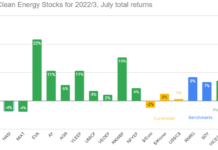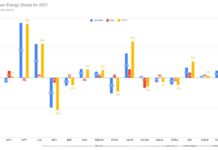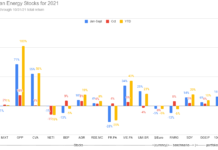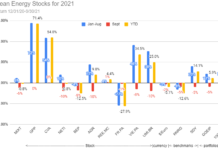Tom Konrad, CFA
A mini-portfolio of stocks that not only are green, but should outperform the market in an environment of increasing concern about climate change and peak oil.
This is the third annual list of green stocks I have published. In 2008, it was a list of ten speculative alternative energy companies (in three parts) that I thought might catch public notice that year. As we all now know, 2008 was a horrible year for speculative stocks, and my stocks were no exception, losing an average of 55% that year, although that still ended up being better than seven out of nine of the sector mutual funds and ETFs that I was then tracking.
In 2009, my ten green stock picks were more conservative, with a focus on profitable companies with good cash flow. The results have been better than I hoped. These 10 picks gained an average of 57%, beating my benchmarks by an even wider margin. I’ll be surprised if I do as well in 2010, but if there’s one thing the stock market delivers reliably, it is surprises.
10 for ’10
In November, I wrote a series of articles for the beginning investor in clean energy, and I plan to follow my own advice with this list, putting emphasis on those clean energy sectors that most investors are not giving enough attention. Once you’ve decided how much of your portfolio to put in clean energy, splitting that investment evenly between these ten stocks should give you exposure to the best clean energy sectors, as well as decent diversification. In other words, these ten stocks are intended as a substitute for a clean energy Exchange Traded Fund (ETF).
In late 2008, when I was putting together my list for 2009, I had a relatively easy time. Fear was rampant, and there were many great companies selling for single-digit multiples of earnings. Today, complacency and greed have returned to the markets, and good values are very hard to come by. The following 10 are mostly the result of culling through our Alternative Energy Stock lists for companies in my favored sectors that look ready for the premature end of the recovery: Companies with strong balance sheets, good cash flow and profitability at not-too-expensive multiples.
Electric Grid & Electricity Storage (30%)
-or-
Efficient/Clean Transportation (30%)
-or-
Energy Efficiency (30%)
Biomass, Waste to Energy, Recycling – 10%

Simplified Portfolio
I’ve provided an alternate, simplified portfolio by substituting the clean energy sector ETFs GRID and PTRP for the stocks in the Electric Grid/Storage and Efficient Transport sectors. This simplified portfolio is better suited for investors who have smaller accounts and want to control transaction costs by making fewer trades. Some investors may also find it difficult to buy London-traded FirstGroup PLC. Such investors may choose to substitute PTRP for FGP.L or for all three efficient transport stocks.
Notes on Stocks
I plan to write about many of these stocks in more depth over the next few months, but here are some links to relatively recent articles for those who want more information before they invest:
- John Petersen on C&D Technologies (December 2009)
- New Flyer Industries update. (October 2009)
- MasTec and General Cable. (June 2009)
- Flir Systems (March 2009)
- Portec Rail Products (February 2009)
Choice of Weights
I was roughly sticking to the sector breakdown I recommended in my Green Energy Investing Target Portfolio, shown here,
but I was constrained by only working with 10 stocks, and wanting to keep the weights equal for simplicity. People who use the simplified version with the two ETFs substituting for six stocks may come closer to the target portfolio, because those ETFs (especially GRID) also contain significant numbers of companies which I would categorize as falling in other clean energy sectors.
Tax Considerations
New Flyer and Waterfurnace pay dividends and trade on Canadian exchanges. Canada withholds 15% of such dividend payments to US-based investors, an amount which can usually be offset as "foreign tax paid" when filing US taxes. Unfortunately, if the stock is held in a non-taxable US account, I don’t believe that it is possible to claim this deduction. In other words, most US based investors will probably do better by holding these stocks in taxable accounts, although you will probably want to consult a tax advisor if you are investing significant sums in these stocks, since your circumstances may not match my experience.
Performance Updates and Benchmarks
As in previous years, I plan to monitor the performance of these stocks quarterly, and to do that, I need benchmarks. An appropriate benchmark should be widely available, consist of the companies in the investment universe from which the portfolio is drawn, and be defined in advance. Since I tend to take a broader view of clean energy than the designers of most clean energy indexes, I historically have used two benchmarks: one broad market benchmark, and one sector-specific benchmark.
In the past, I’ve used the S&P 500 index as my broad market index, but some readers have rightly criticized it because it is mostly composed of larger capitalization stocks than my picks, so this year I will use the Russell 3000 index. For in industry benchmark, I’ll used the oldest and most widely held of the clean energy ETFs, the Powershares WilderHill Clean Energy Portfolio (PBW.)
| Security (Ticker) | Price 12/27/09 | Shares* in a $10,000 10 for ’10 Portfolio: |
Shares* in the $10,000 Simplified Portfolio |
| General Cable (BGC) | $32 | 31.25 |
n/a |
| MasTec (MTZ) | $12.54 | 79.745 | |
| C&D Technologies (CHP) | $1.47 | 680.27 | |
| $32.58 |
n/a |
92.081 | |
| $9.4853 | 105.43 |
n/a |
|
| Firstgroup PLC (FGP.L) (in US$) | $6.6246 | 150.95 | |
| Portec Rail Products (PRPX) | $10.21 | 97.943 | |
| $27.1885 |
n/a |
110.34 | |
| Waterfurnace, Inc. (WFI.TO, WFFIF.PK) | $24.0335 | 41.609 | |
| Linear Technology Corp (LLTC) | $30.77 | 32.499 | |
| Flir Systems, Inc. (FLIR) | $32.24 | 31.017 | |
| Waste Management (WM) | $33.76 | 29.621 | |
| Total | $10,000 | $10,000 | |
| Russell 3000 (^RUA) | 660.44 | 15.14142 | |
| Powershares WilderHill Clean Energy Portfolio (PBW) | 11.15 | 896.861 | |
*Fractional shares would not be used in a real portfolio, and there would of course be transaction costs reflected here as well. These are simply the weights I’ll be using to track my model portfolio.
DISCLOSURE: Long CHP, LLTC, NFYIF, WFIFF, PRPX, and WM.
DISCLAIMER: The information and trades provided here are for informational purposes only and are not a solicitation to buy or sell any of these securities. Investing involves substantial risk and you should evaluate your own risk levels before you make any investment. Past results are not an indication of future performance. Please take the time to read the full disclaimer here.









I’ve been waiting for input as to how best to increase my energy efficiency holdings. I’ll be eager to read your analysis on LLTC especially. Thanks as always. One thing I’ll be selling now will be JCI.
As for CHP, does the stock have a clear advantage in your mind over AXPW?(another stock Peterson recommends)
I consider CHP a safer stock than AXPW. Bot the potential returns are potentially larger.
The fact that JCI is not in this list does not mean I’m negative about it…. it just means I like the other three more. It’s still a good company, but I decided to focus on purer play stocks this year.
Yes, purer play makes a lot of sense. JCI’s exposure to the traditional auto industry makes it vulnerable to contraction in the same scenario that would benefit a progressive transport stock like New Flyer.